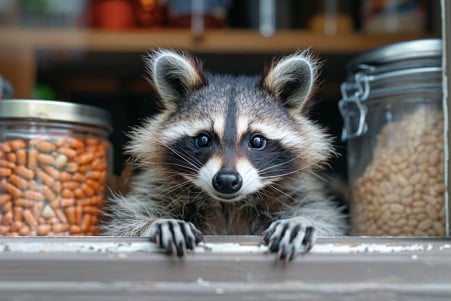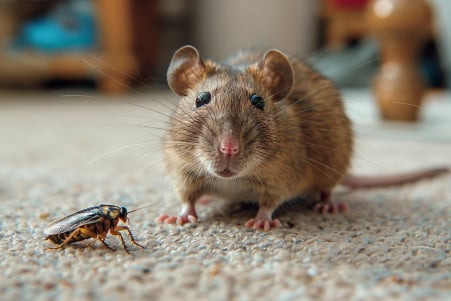Why Do Rats Eat Mice? An Investigation into Rodent Predation
1 March 2024 • Updated 29 February 2024

Given the complex nature of the animal kingdom’s food web, do rats eat mice? Rats are opportunistic omnivores and will eat mice, especially when other food is hard to come by. When rats eat mice, a phenomenon called muricide, they tend to go for the head and neck to make sure they can outcompete their fellow rodents for resources.
This article investigates the predatory behavior of rats by looking at research across the disciplines of behavioral ecology, neuroethology, and urban wildlife studies. This investigation aims to understand why rats eat mice by looking at the environmental pressures and interspecific competition that drive this behavior. This, in turn, helps to give a more complete picture of the ever-changing and sometimes cutthroat world of rodent survival.
Why do rats eat mice?
Rat Diets: From Fruits to Foes
Rats eat a wide range of foods, which is consistent with their omnivorous diet. Their diet typically consists of a smorgasbord of fruits like bananas, apples, and pears, vegetables like carrots and peas, and a variety of nuts and seeds that give them the nutrients they need to survive.
According to a study by Eliminate Pest Control, rats’ tastes are similar to humans’ in that they like sweet and salty foods, but they prefer grains to other carbohydrates like corn.
Yet, while rats are gourmands when it comes to grains, they are also survivors who are able to adapt their diets to meet the demands of their environment. This means they will eat things they wouldn’t normally eat if they are forced to by environmental factors.
This can include eating other animals, such as mice and insects, and coprophagy, which is the act of eating their own feces to get nutrients that weren’t absorbed during the first round of digestion, according to the same pest control company.
When rats are forced to eat mice due to a lack of food and competition for resources, it’s called muricide. According to Wildlife Removal, this behavior is mostly caused by hunger.
This flexibility in their diet is just one example of how rats can adapt to different environments. Their ability to adapt to different environments ensures that they can survive in a variety of places, from urban areas where they can eat from dumpsters to the wild.
Predatory Aggression in Rats
Muricide, the killing and sometimes eating of mice by rats, is an example of predatory aggression in rats. Muricide is often driven by environmental factors, such as a lack of food, that force rats into a predatory role.
A study in ScienceDirect that looked at brain activity during spontaneous muricide in rats found that the rats that exhibited muricide had increased activation in the central and basolateral amygdala and the lateral hypothalamus. This pattern of neural activation is similar to that seen in other animals during predatory aggression, suggesting an evolutionarily conserved mechanism.
Another study in the Proceedings of the National Academy of Sciences delved deeper into the neurobiology of predatory aggression in rats and showed that the amygdala plays a key role in the regulation of predation risk. The study showed that the amygdala balances the basic need to forage with the risk of being eaten by a predator, which the authors say highlights the amygdala’s importance in survival behaviors.
In addition to being innate, rats’ predatory hunting is also a product of environmental adaptability. This behavior can have a big impact on the prey species, such as mice, and can influence ecological systems and population dynamics.
A study in Neuroscience Bulletin investigated the neurocircuitry of predatory hunting and suggested that it is closely tied to survival and the brain’s ability to efficiently process sensory information. Rats’ predatory hunting of mice as they move through their environments is a clear example of the complex relationship between predator and prey and the ongoing battle for survival.
Interspecific Competition: Territoriality and Muricide
Interspecific competition is a major ecological interaction, especially between rodents like rats and mice. This competition for resources often results in territoriality, where the dominant or more aggressive species, in this case rats, defends a territory that can impact the survival of the less dominant species, in this case mice.
As a study in Evolutionary Ecology notes, interspecific competition can lead to territoriality that can affect individual traits and behaviors, showing how these species have evolved to adapt to ecological pressures.
However, the relationship between rats and mice isn’t just about territory, it’s about life and death. Rats’ territoriality can lead directly to muricide, a predatory behavior in which rats kill invading mice.
As a study in Integrative and Comparative Biology explains, when subordinate species are faced with challenging conditions like competition or limited resources, they may use strategies like torpor to conserve energy, a strategy that’s less available to the predatory rat. This can lead to an increase in the rat’s aggressive and predatory behaviors, including muricide.
This means that the interactions between rats and mice through interspecific competition make it much more likely that rats will engage in muricide. As the two species compete for the same resources, the conflict that arises from this competition can change the makeup of the rodent community, with rats increasingly turning to predation to maintain their territoriality and survival in a shared environment.
Urban Ecosystems and Rat Predatory Patterns
Urbanization has had a profound impact on rat behavior, disrupting their natural ecological niche, diet, and even their role as predators. As cities have grown, native plants have been displaced, leading to significant changes in the availability of food and predatory relationships.
A study in PMC notes that while urbanization has not impacted the abundance of small rodents, it has changed the makeup of their populations. Rats, with their ability to adapt, have been shown to become more opportunistic predators, preying on mice as their natural food sources have been impacted by urbanization.
The high density of humans and the infrastructure that comes with urbanization has also impacted rat territoriality and the competition for resources. A study in the Journal of Urban Ecology explains that the nature of urban ecosystems makes it difficult to understand and control rat populations. This adaptability can lead to rats coming into contact with humans and other animals more frequently, which may change the nature of predator–prey relationships.
To understand the likelihood of rats preying on mice in urban areas, it’s important to understand the new ecological relationships that have been created.
A study in the Proceedings of the National Academy of Sciences on urbanization in Southeast Asia suggests that the environmental pressures of urbanization may increase the risk of zoonotic diseases, which would require rats to come into closer and more frequent contact with other species, including potential prey like mice.
This, along with the pressure that urbanization puts on rats’ natural food sources, may mean that rats are more likely to turn to muricide to survive in the city.
The Omnivorous Opportunist: A Summary of Rat Feeding Behavior
Our exploration of the rat’s feeding behavior has shown it to be an animal of incredible flexibility and adaptability. In response to changing circumstances, rats have an omnivorous diet that is the basis of their survival. From their preference for fruits and grains to the less appetizing act of coprophagy, rats have shown they are willing to adapt to their food sources.
This review has shown that rats do eat mice, but only when the circumstances of their environment and the pressures of competition force them to. The environmental pressures of urbanization and the natural pressures of the competition for space also play a role in their predatory behavior, with muricide often being a response to these pressures.
When we consider the adaptability and survival skills of rats, we can see that they are incredibly adept at navigating and taking advantage of different environments. Our review has important implications for urban pest management and wildlife conservation, showing the need for interventions that take into account the complicated behaviors and ecological roles of these animals.
As cities continue to grow, understanding the many sides of rat feeding behavior will be important in controlling their numbers and protecting public health.


